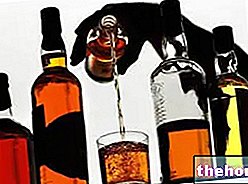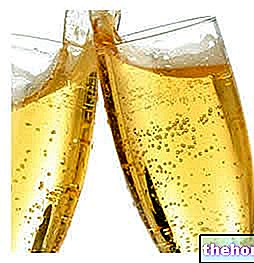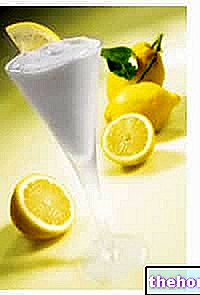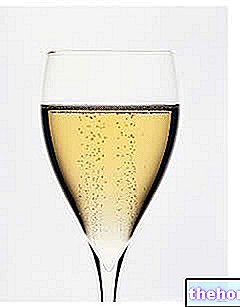Generality
The nocino is a liqueur obtained from the infusion of the husk of common walnuts (fruits of the plant Juglans regia L.) in ethyl alcohol.
The husk is the fleshy portion of the drupe (fruit), under which the real walnut is housed, consisting of the woody endocarp (shell) to protect the seed (the kernel or the edible part).

Regulation of nocino, taken from the text: Food Legislation - by Gennaro Calì (I edition) - pag. 549.
Nocino is the liqueur that is mainly flavored by the maceration and / or distillation of whole green walnuts (fruit of the Juglans regia plant, Linnea classification), having a sugar content NOT less than 100g / l, expressed as invert sugar. The minimum alcohol-metric strength by volume of the nocino is 30% Vol. The rules set out in category 32 for liqueurs in relation to flavoring substances and aromatic preparations apply to nocino. The sales denomination can be completed with the term liqueur.
Nocino is NOT a drink to be consumed freely and the relative alcohol unit is clearly much lower than that of wine and beer.
Background
The origins of nocino are rather uncertain, since walnut-based liqueurs have been consumed since ancient times in much of the old continent (excluding African territories).
It is however conceivable that the origin of nocino is closely related to the history of British or French liqueurs. To be precise, according to the most quoted hypothesis, the nocino would have "bypassed" the Maritime Alps to descend into the Po valley, taking root first in the Savona area (in Liguria) and then in the Modenese area (in Emilia Romagna); not surprisingly, the nocino Emilia is by far one of the most delicious, even if the liqueur tradition affects several hilly provinces of the Italian peninsula (including the islands and the South).
Nocino has been considered a kind of "magic drink" since ancient times. Its production should in fact respect a very specific rite, which involves hand-picking the unripe fruit on the night between 23 and 24 June (San Giovanni Battista); the operation should be carried out by a very expert woman (who vaguely recalls the profile of a witch) and requires the rest of the walnuts on the ground until the following morning. The next day, the walnuts must be engraved with NON-metallic tools and infused for about 17 weeks, or until October 31st (Saints' Day).
Preparation
The following formula was obtained from the web page of the "Order of the Modenese Nocino (Medieval Tower C.so Umberto I Spilamberto - Mo); however, to get a "precise idea of the preparation of nocino, I suggest consulting Alice's video recipe on the page: Nocino - Liqueur with walnuts.
Nocino - Homemade Walnut Liqueur
Problems with playing the video? Reload the video from youtube.
- Go to the Video Page
- Go to the Video Recipes Section
- Watch the video on youtube
Recipe of Nocino According to the "Ancient Tradition of the Order of the Modenese Nocino
Nocino ingredients: 1 liter of alcohol at 95 °, 700-900g of sugar, 1kg of green unripe walnuts with husk (n ° 33 or 35) NOT TREATED. *. Optional: cloves and cinnamon to taste.
* NB. The recipe in question does not include the addition of water.
Nocino process: Cut the walnuts into 4 and place them in a glass container without seals together with the sugar; expose the jar to the sun for 1-2 days, stirring daily. Add the alcohol with any aromas and place again in the sun, opening and stirring from time to time, for a total duration NOT less than 60 days (at night, it is better to withdraw the jar inside the house). In due time, filter and bottle the liquid in dark glass containers, possibly refine the walnut in small treated wooden barrels (oak or chestnut) Store in a cool place for at least 12 months.
ATTENTION! This is an extremely alcoholic recipe that requires the right maturation times. We remind you that granular sugar is a rather recent invention and that in ancient times it was not used; this means that this formula did NOT have to take into account the solubility of sucrose, even if, in a total time of 16 months, it should not constitute a drawback. .
Nutritional Characteristics
Nocino is a very alcoholic drink rich in simple sugars. Like limoncello, maraschino, grappa, gin, Marsala etc., nocino also does NOT lend itself to frequent or systematic consumption. Since it is a spirits, its portion (if desired) must be limited to about 1-2 glasses of 30ml per day and it would be convenient for the frequency of consumption to be occasional.
The excessive and close consumption of nocino can be harmful to health, especially in the case of metabolic diseases. Nocino is EXTREMELY not recommended for: hypertensive people (due to the hypertensive effect of alcohol), diabetics (due to the high content of simple sugars, despite the hypoglycemic effect of ethyl alcohol), hypertriglyceridemics (due to the high content of ethyl alcohol and simple sugars), overweight subjects (due to the high total caloric value and the isulin-stimulating effect of alcohol), pregnant women (due to the teratogenic effect of ethyl alcohol on the fetus) and, in generally, to all people suffering from metabolic syndrome, hepatic steatosis (alcoholic and / or alimentary) and impaired gastric mucosa.
Nocino contains high quantities of tannins, respectively released by the husk. These compounds, which seem to have significant antioxidant functions, inactivate certain digestive enzymes and perform a chelating action (iron, zinc, certain vitamins, etc.). This action is considered to be ANTInutritional, as it reduces the body's molecular absorption capacity.
The energy intake, the alcohol content and the sugar content of nocino depend on the specific recipe, but as we have seen they tend to be high.
Other Alcoholic Alchermes Alcohol test Alcopops Cocktail Alcoholic Alcoholic units calculation Cognac Gin Grappa Alcoholic degree Grappa Limoncino Maraschino Marsala Nocino Prosecco Rum Rum Sherry Sparkling wine Spirits Wine Port wine Vermouth Vodka Vov Whiskey Categories Alcoholic foods Meat Cereals and derivatives Sweeteners Sweets Offal Dried fruit Milk and derivatives Legumes Oils and fats Fish and fishery products Cold cuts Spices Vegetables Health recipes Appetizers Bread, Pizza and Brioche First courses Second courses Vegetables and salads Sweets and desserts Ice creams and sorbets Syrups, liqueurs and grappas Basic preparations ---- In the kitchen with Leftovers Carnival recipes Christmas recipes Light diet recipes Women's, mom's and dad's day recipes Functional recipes International recipes Easter recipes Celiac recipes Diabetic recipes Holiday recipes Valentine's Day recipes Vegetarian recipes Protein recipes Regional recipes Vegan recipes




























